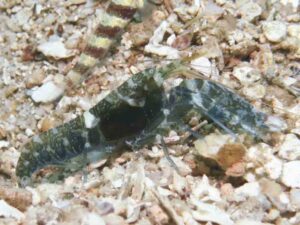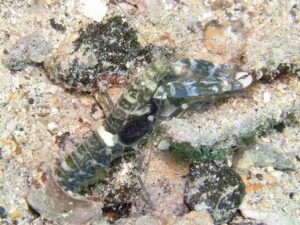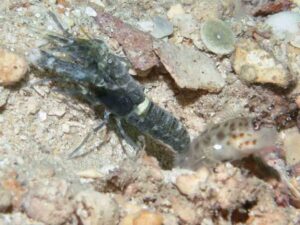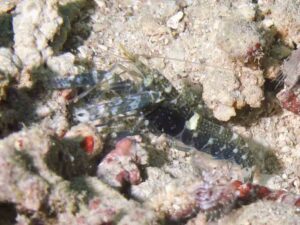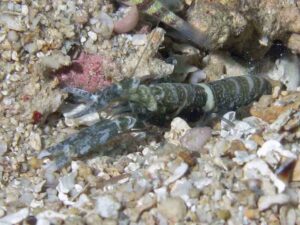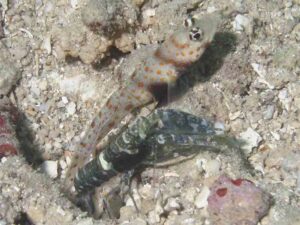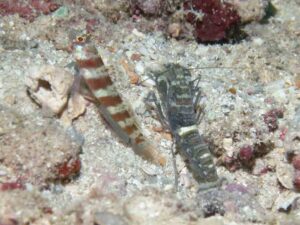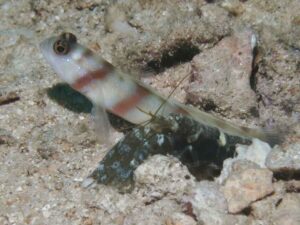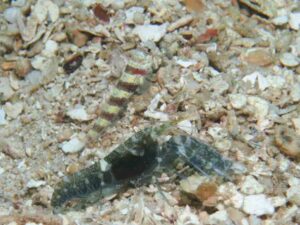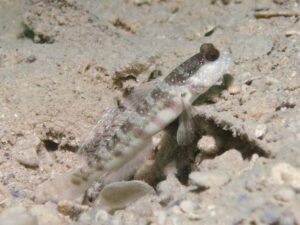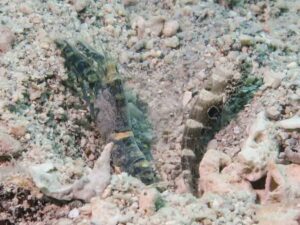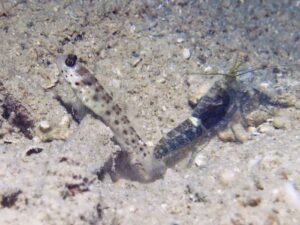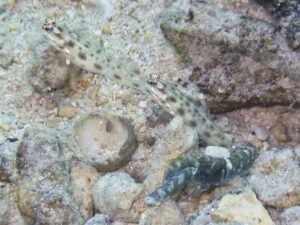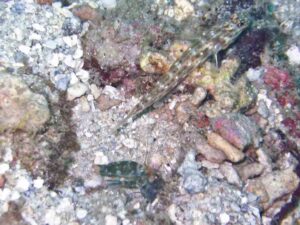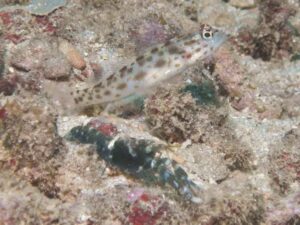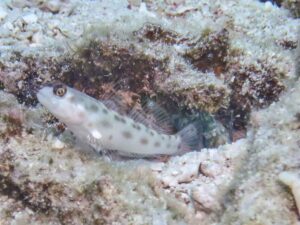Dark Marbled Snapping Shrimp
Alpheus macellarius
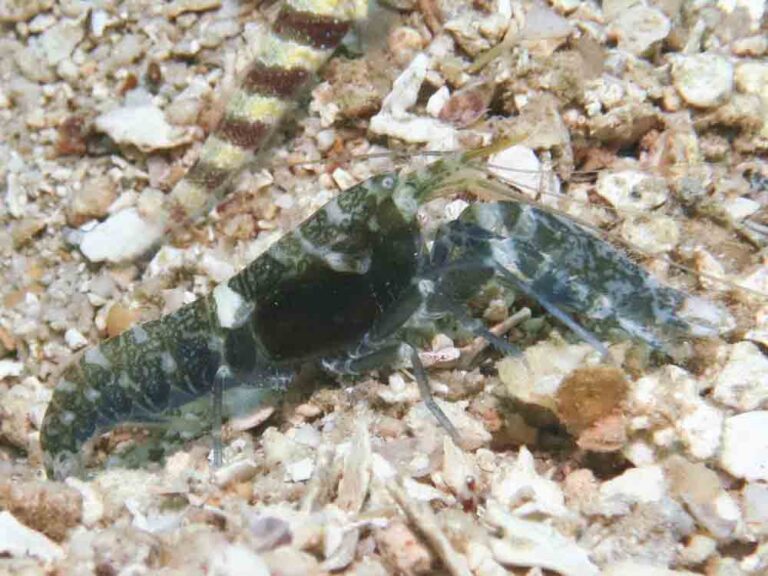
Dark Marbled Snapping Shrimp
Alpheus macellarius
Chase, 1988
Description
Carapace: Dark green above with paler marbling and 3 or 4 transverse white bands, one of which terminates in a well-defined epaulette on the side of the carapace. The entire side of the carapace is otherwise very dark green-black.
The abdomen is marbled dark green. The first segment is separated from the carapace by a prominent white band. Fainter transverse bands are present on the other segments and there is a pale green spot mid-laterally on each segment.
The rostrum and antennae are yellow-green.
The pincers are marbled green with white tips on dactyl and pollex. The chelate second legs are blue-green with pale joints. The walking legs are blue-green with pale green joints.
The tail fan has dark blue scutes with pale green centres.
Identifying Features
Dark Marbled Shrimp is dark green with a prominent black patch on the side of the carapace. A vivid white bar is at the junction of the carapace and abdomen.
Similar Shrimps
There could be confusion with the Black-sided Shrimp. They are not unduly similar but both are green shrimps with a black patch on the side of the carapace. In both, there is a defect in the patch. The defect in the black patch on the side of the carapace of Dark Marbled Shrimp is caused by the epaulette and is not in the same place as the more clearly circumscribed defect in the Black-sided Shrimp.
Nomenclature
Ryanskiy (2016) p8. has images of a similar-looking shrimp and gives the name Alpheus macellarius, common name Butcher Snapping Shrimp. Length up to 3 cm. Distribution Indo-West Pacific – Philippines, Indonesia. The holotype came from Cebu market, Philippines in 1909. The species name is derived from the Latin word for “of the meat or provision market”.
Humann & DeLoach (2010) p84 has images of a similar-looking shrimp and gives the name Alpheus djiboutensis, common name Djibouti Snapping Shrimp. Size to 4 cm. Indo-West Pacific from Indonesia to the Solomon Islands. Identification is tentative.
Roger Steene’s (2015) Colours of the Reef page 407 has a vividly marked individual on black sand labeled Alpheus djiboutensis.
The name Alpheus macellarius is associated with images of Pale Marbled Shrimps (usually with Cryptocentrus maudae), on several internet sites. We believe this is a misidentification.
We are provisionally using Alpheus macellarius Chase, 1988 for the Dark Marbled Shrimp.
Alternate common name:
Butcher Snapping Shrimp (Ryanskiy 2015).
Ecology
HABITAT
Preferred substrate Burrows are constructed in patches of clear sand in the coral rubble that accumulates around the base of coral reefs. This coarse sand is unstable and the entrance is strongly reinforced with coral and shell fragments.
Deeper on the reef slope the sand becomes finer and more adherent and there is less reliance on using pebbles to shore up the entrance.
Depth from 4 to 15 metres
Proximity to reef It lives in the shallows and on the reef slope.
NATURAL HISTORY
It is a common species readily encountered by Scuba divers as it is essentially a coral reef species. It forms an association with most of the gobies of the genera Amblyeleotris and Ctenogobiops that favour the shallows.
Laboratory observations and stable isotope studies suggest these shrimp primarily feed on seagrass and sediment organic matter (Palomar et al 2004). The Dark Marble Shrimp actively cuts fresh seagrass leaves, shreds them, and stores them in special chambers in their burrows. In this way, it may function in nutrient cycling in seagrass meadows (Vonk et al 2008).
Behavioural observations suggest shrimps build and maintain burrows in the morning, and groom/forage/feed primarily in the afternoon (Palomar et al 2004, 2005)
Feeds on seagrass and detritus, Ryanskiy (2016).
Distribution
Published distribution: Indo-West Pacific, South Central Philippines (Chase 1988). South Sulawesi, Indonesia, (Vonk et. al 2008). Indo-West Pacific: Philippines and Indonesia, Ryanskiy (2016)
Our records: Australia; Lizard Island, Ribbon Reef 3, Low Isles.
Solomon Islands; Ghizo, Kolombangara Island, Maravagi, Russell Islands, Soghonangola Island, Soghanara Island.
Indonesia; Kabui Bay in Waigeo Island.
Associated Goby species
Associated Shrimpgobies (eleven species)
Amblyeleotris guttata, Blackchest Shrimpgoby
Amblyeleotris periophthalma, Broadbanded Shrimpgoby
Amblyeleotris steinitzi, Steinitz’s Shrimpgoby
Amblyeleotris wheeleri, Burgundy Shrimpgoby
Cryptocentrus leptocephalus, Pinkspot Shrimpgoby
Cryptocentrus strigilliceps Target Shrimpgoby
Ctenogobiops aurocingulus, Goldstreaked Shrimpgoby
Ctenogobiops crocineus, Silverspot Shrimpgoby
Ctenogobiops feroculus, Sand Shrimpgoby
Ctenogobiops mitodes, Thread Shrimpgoby
Ctenogobiops pomastictus, Goldspeckled Shrimpgoby

